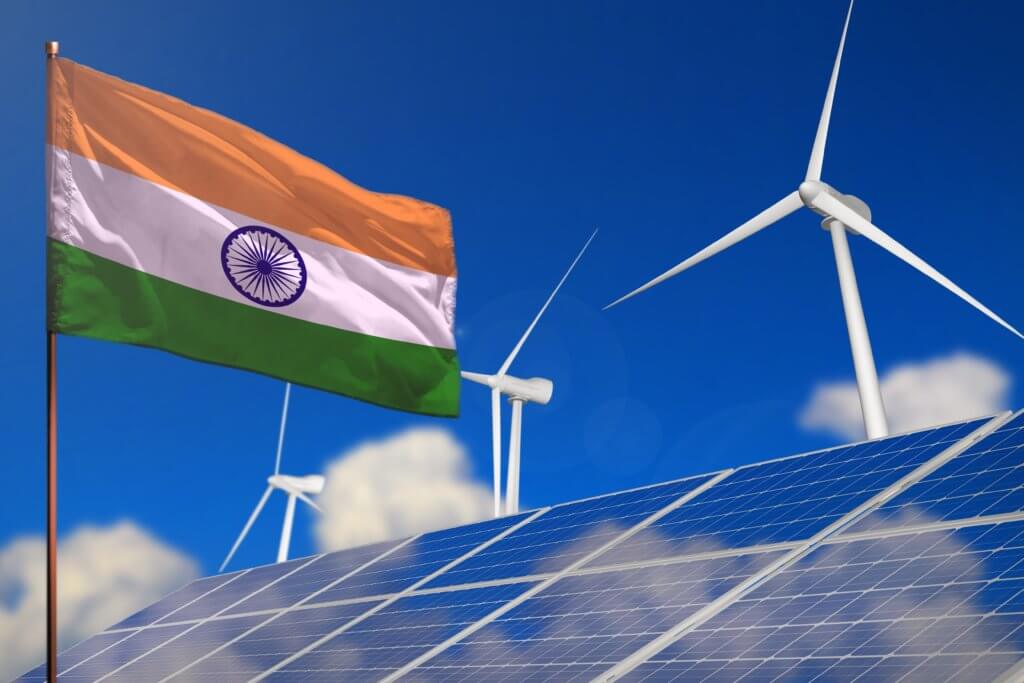

India is transforming at an unprecedented pace and scale – a change that signals growth with the core principles of sustainability. Morgan Stanley says India is set to overtake Japan and Germany as the world’s third-largest economy by 2030. London-based consultancy CEBR predicts that India will be the third US$10 trillion economy by 2035. To achieve this, India will have to implement 4 D’s – democracy, demography, diversity and digitisation.
One key element that’s been discussed extensively is energy transition. India pledged to achieve net-zero emissions by 2070 at COP26 and achieved its NDC (Nationally determined contributions) target of 40% coming from non-fossil fuels by 2030 in 2021 itself. As of March 31, 2023, the country’s power sector is growing at 8.87% per annum and 43% of the energy generated in India was from non-fossil fuels. Another interesting fact to illustrate this “pace” of change is the average per capita consumption of electricity in the country is about a third of the global average, thereby highlighting the “scale” of opportunities in India.
Renewable energy growth
India has the fourth largest installed renewable capacity in the world. In the last five years, about 66,000MW of capacity has been added, more than 90% of which is from renewable energy. India’s renewable energy capacity has grown exponentially in the last seven years. Since 2017, the additional capacity rose to 71%, specifically from renewables, dominated mainly by solar projects. India has the lowest levelized cost of energy (LCoE) renewable power in the world.
About 26% of India’s total solar capacity was added in FY 2022 and tariffs dropped 63% 2021, resulting in affordability.
The country has set an ambitious energy transition target of reaching 500GW of non-fossil fuel power capacity by 2030 (currently at 167GW renewable + hydro + nuclear). The government is also targeting to achieve 50% of electricity requirements by renewables with the aim to lower the carbon intensity of the economy by more than 45% by 2030.
India launched the National Green Hydrogen Mission in January 2022, with the intended objectives of becoming the leading producer and supplier of ssgreen hydrogen in the world, reducing the fossil fuel import bill of more than Rs 1 trillion (US$12 billion) and reduction of nearly 50 MMT of annual greenhouse gas emissions.
The potential is enormous with rapid pace and government-backed ambition as well as their commitment to make this transition successful.
Transition to renewables
On the micro side, solar power dominates the “transition-to-renewables” story. Millions of homes have benefited from the decentralisation of solar based applications for cooking, lighting and homes turning into solar power stations across India.
With rising electricity costs and increasing awareness about sustainability and environmental impact of conventional electricity, many homeowners are turning to solar panels for their energy needs. Typically, about 10-15 panels will generate about 3-5 KW of power enough to meet a small homeowner’s needs depending on the amount of sunlight, as well as the efficacy of the panel.
In 2021, the Indian government launched the solar rooftop programme. Several states took up this programme to reduce their reliance on imported power. Registered domestic users were given subsidies along with technical guidance to embrace rooftop solar.
Aside from this, there are similar programmes for biogas, waste-to energy generation, wind, research and fellowship schemes to provide further impetus to this transition.
Mitigating climate change
Donning the mantle of leadership at the G20 this year, India’s priorities are energy and climate change mitigation. As India strides into the renewable journey, it does so with a millstone around its neck. The main factors slowing this growth could potentially be:
Heavy dependence on thermal power. There has to be a clear coal step-out plan and a schedule for the retirement of existing coal capacities.
Struggling state distribution companies. Renewable power contributes only 12% of power generation despite having a 26% share in installed capacity. Because renewable power is also intermittent and variable, there is no steadiness in availability. Hence, it’s a challenge for state distribution companies that are struggling and need guaranteed supply. This is due to the fact that they are unable to manage the flow of thermal power or improve forecasting abilities.
Several private companies have invested heavily in the renewable energy sector. Others have made ESG commitments to increase the share of renewable power in their portfolios. However, all these efforts can be dampened due to technological challenges at state distribution companies and their need to maintain their market share.
Availability of capital. Funding is largely from the private funds and private pools of capital. There are several government subsidises available but if cost of financing for such growth increases, it will be passed down to consumers reducing attractiveness of the transition.
State-wise variance in open consumer adaptability. It is no secret that every state’s agenda can vary from that of the central government. In order to build a stable domestic supply chain, all stakeholders must come together in lock-step to move forward. A single national synchronised interstate grid is key to sustainable scalability.
If you flip the story, the above factors could potentially stimulate providers for further growth. It has been proven by the tremendous growth in renewable energy companies in India:
Adani Green, which has the largest operating renewable portfolio in India; Tata Power Solar is the largest integrated solar power player in India; Azure and RENew are other companies at the forefront of this solar growth story. National Thermal Power Corporation of India – the public sector giant – also focuses on this area through NTPC Renewable Energy, a fully owned subsidiary.
The company announced that it has added more than 1.3 GW of renewable capacity in FY 2023. Reliance Industries, the behemoth of the energy sector in India, has committed to invest US$8 billion in this sector and already forged key technology partnerships which will also differentiate its position in the international energy market.
Reliance reckons that renewable energy will replicate its success in telecom within the decade. Some of these companies have gone a step further focusing on hybrid solar (combining wind and solar generation) and also floating solar projects (where no land is required for installation).
So why is it exciting for insurance?
The answer is intuitive. All these renewable energy projects definitely need insurance and investments in order to achieve growth both operationally as well as the construction side. As the need to mitigate the traditional and/or emerging risk increase, it will lead to higher demand for insurance – either traditional or parametric. About 59 solar parks of aggregate capacity 40 GW have been approved in India.
Solar Parks in Pavagada (2 GW), Kurnool (1 GW) and Bhadla-II (648 MW) are included in the top five operational solar parks of 7 GW capacity in the country.
The world’s largest renewable energy park of 30 GW capacity solar-wind hybrid project is under installation in Gujarat. A floating solar project in Omkareshwar reservoir is set to be the world’s largest floating solar power plant with planned capacity of 600 MW. Solar canal pilot project in the state of Gujarat is in the pipeline and these are just a few to demonstrate the burgeoning activity.
As investment in manufacturing activities heighten, the demand in the ancillary industries will increase as well. Since this is a new space, with limited loss history, it requires nimbleness and innovation to forge a meaningful presence.
Allianz is here
At Allianz, we emphasise that our clients treat ESG as a significant part of their growth strategy. Our key partners in the Indian market are highly focussed on ESG and constantly innovate solutions in this domain, not only with Allianz, but with several other top tier reinsurers as well. Solutions vary from insurance for erection/construction, operation, solar panel warranty, package policies for solar panel installation and even solar energy shortfall insurance.
Thus as we worship the Sun God, we are also prepared for lack-of-solar cover, which insures change in irradiation to smooth revenues and reduce volatility.
There are also political risk insurance solutions to protect investors against financial losses on their equity investments due to a variety of non-commercial risks. Environmental risk insurance, liability insurance, damage coverage, non-damage protection, performance guarantee and even marine transit as well as cyber will see an uptick in demand. Each of these is a part of a puzzle that comes together to provide financial protection and address technological challenges that stand in the way of adaptability both for industrial and retail renewable energy.
While providing an accurate growth rate for reinsurance is a challenge, it will certainly outpace the growth rate of the India insurance industry, which is growing at +12%, by a healthy margin. In many of our cedents’ portfolios, Allianz Re is already seeing a greater focus on this segment and as our clients make this transition, we would like to be their partner in this journey.
We seek to provide expertise apart from capacity and set targets along with our clients. Pushing cedents to reduce dependence on conventional sources is obvious but not enough, we have to assist them through that learning curve and be ready to iterate as the journey evolves.
 |
Sonia Rawal
P&C and Agriculture Client Manager, India
Email: [email protected] |
-
Allianz General | Allianz General combines innovative protection solutions while powering social good to lead Malaysian market
The insurer proactively addresses emerging risks and evolving customer protection needs while giving back to the community.
-
Sedgwick | Asia’s Energy Transformation – Balancing Growth, Risk and Renewables
Energy market presents unique risks, especially in a region which includes China and Japan as well as developing nations like Vietnam and the Philippines.
-
Beazley | Turbulent Waters: the maritime energy transition challenge
Businesses are facing a complex transition to non-carbon energy sources amid a push to achieve net-zero emissions for the marine sector by 2050.
-
Aon | Navigating shifts in the global and Asia insurance markets
Neelay Patel, Aon head of growth for Asia, says the market in Asia is at an ‘interesting stage of the cycle’.
